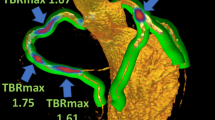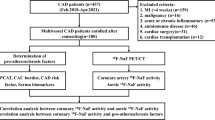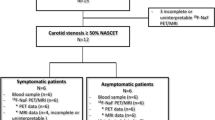Abstract
Background
Fluorine-18 sodium fluoride (Na[18F]F) atherosclerotic plaque uptake in positron emission tomography with computed tomography (PET-CT) identifies active microcalcification. We aim to evaluate global cardiac microcalcification activity with Na[18F]F, as a measure of unstable microcalcification burden, in high cardiovascular (CV) risk patients.
Methods and Results
Thirty-four high CV risk individuals without previous CV events were scanned with Na[18F]F PET-CT. Cardiac Na[18F]F uptake was assessed through the global molecular calcium score (GMCS), which was calculated by summing the product of the mean standardized uptake value times the area of the cardiac regions of interest times the slice thickness for all cardiac transaxial slices, divided by the total number of slices. Mean age is 63.5 ± 7.8 years and 62% male. Median GMCS is 320.9 (240.8-402.8). Individuals with more than five CV risk factors (50%) have increased GMCS [356.7 (321.0-409.6) vs. 261.1 (225.6-342.1), P = 0.01], which is positively correlated with predicted fatal CV risk by SCORE (rs = 0.32, P = 0.04). There is a positive correlation between GMCS and weight (rs = 0.61), body mass index (rs = 0.66), abdominal perimeter (rs = 0.74), thoracic fat volume (rs = 0.47), and epicardial adipose tissue (rs = 0.41), all with P ≤ 0.01. There is no correlation between GMCS and coronary calcium score nor coronary artery wall Na[18F]F uptake.
Conclusions
In a high CV risk group, the global cardiac microcalcification burden is related to CV risk factors, metabolic syndrome variables and cardiac fat. Cardiac GMCS is a promising risk stratification tool, combining a straightforward and objective methodology with a comprehensive analysis of both coronary and valvular microcalcification.



Similar content being viewed by others
Abbreviations
- CAC:
-
Coronary artery calcium score
- CAD:
-
Coronary artery disease
- CT:
-
Computerized tomography
- CV:
-
Cardiovascular
- GMCS:
-
Global molecular calcification score
- Na[18F]F:
-
Fluorine-18 sodium fluoride
- PET:
-
Positron emission tomography
- ROI:
-
Regions of interest
- SUV:
-
Standard uptake value
- TBR:
-
Target-to-background ratio
References
Saraste A, Barbato E, Capodanno D, Edvardsen T, Prescott E, Achenbach S, et al. Imaging in ESC clinical guidelines: Chronic coronary syndromes. Eur Heart J Cardiovasc Imaging 2019;20:1187-97.
Mach F, Baigent C, Catapano A, Koskinas K, Casula M, Badimon L, et al. 2019 ESC/EAS guidelines for the management of dyslipidaemias: Lipid modification to reduce cardiovascular risk. Atherosclerosis. 2019;290:140-205.
Blaha MJ, Mortensen MB, Kianoush S, Tota-Maharaj R, Cainzos-Achirica M. Coronary artery calcium scoring: Is it time for a change in methodology? JACC Cardiovasc Imaging 2017;10:923-37.
Silva Mendes BI, Oliveira-Santos M, Vidigal Ferreira MJ. Sodium fluoride in cardiovascular disorders: A systematic review. J Nucl Cardiol 2019. https://doi.org/10.1007/s12350-019-01832-7.
Dweck MR, Chow MW, Joshi NV, Williams MC, Jones C, Fletcher AM, et al. Coronary arterial 18F-sodium fluoride uptake: A novel marker of plaque biology. J Am Coll Cardiol 2012;59:1539-48.
Czernin J, Satyamurthy N, Schiepers C. Molecular mechanisms of bone 18F-NaF deposition. J Nucl Med 2010;51:1826-9.
Irkle A, Vesey AT, Lewis DY, Skepper JN, Bird JL, Dweck MR, et al. Identifying active vascular microcalcification by (18)F-sodium fluoride positron emission tomography. Nat Commun 2015;6:7495.
Derlin T, Richter U, Bannas P, Begemann P, Buchert R, Mester J, et al. Feasibility of 18F-sodium fluoride PET/CT for imaging of atherosclerotic plaque. J Nucl Med 2010;51:862-5.
Moghbel M, Al-Zaghal A, Werner TJ, Constantinescu CM, Hoilund-Carlsen PF, Alavi A. The role of PET in evaluating atherosclerosis: A critical review. Semin Nucl Med 2018;48:488-97.
Joshi NV, Vesey AT, Williams MC, Shah AS, Calvert PA, Craighead FH, et al. 18F-fluoride positron emission tomography for identification of ruptured and high-risk coronary atherosclerotic plaques: A prospective clinical trial. Lancet 2014;383:705-13.
Beheshti M, Saboury B, Mehta NN, Torigian DA, Werner T, Mohler E, et al. Detection and global quantification of cardiovascular molecular calcification by fluoro18-fluoride positron emission tomography/computed tomography-a novel concept. Hell J Nucl Med 2011;14:114-20.
Oliveira-Santos M, Castelo-Branco M, Silva R, Gomes A, Chichorro N, Abrunhosa A, et al. Atherosclerotic plaque metabolism in high cardiovascular risk subjects: A subclinical atherosclerosis imaging study with (18)F-NaF PET-CT. Atherosclerosis 2017;260:41-6.
Piepoli MF, Hoes AW, Agewall S, Albus C, Brotons C, Catapano AL, et al. 2016 European Guidelines on cardiovascular disease prevention in clinical practice: The Sixth Joint Task Force of the European Society of Cardiology and Other Societies on Cardiovascular Disease Prevention in Clinical Practice (constituted by representatives of 10 societies and by invited experts)Developed with the special contribution of the European Association for Cardiovascular Prevention & Rehabilitation (EACPR). Eur Heart J 2016;37:2315-81.
Rawlings R, Nohria A, Liu PY, Donnelly J, Creager MA, Ganz P, et al. Comparison of effects of rosuvastatin (10 mg) versus atorvastatin (40 mg) on rho kinase activity in caucasian men with a previous atherosclerotic event. Am J Cardiol 2009;103:437-41.
Domingues C, Joao Ferreira M, Silva R, Oliveira-Santos M, Andreia G, Chichorro N, et al. Aortic valve microcalcification and cardiovascular risk: An exploratory study using sodium fluoride in high cardiovascular risk patients. Int J Cardiovasc Imaging 2020;36:1593-8.
Ferreira MJV, Oliveira-Santos M, Silva R, Gomes A, Ferreira N, Abrunhosa A, et al. Assessment of atherosclerotic plaque calcification using F18-NaF PET-CT. J Nucl Cardiol 2018;25:1733-41.
Dey D, Nakazato R, Li D, Berman DS. Epicardial and thoracic fat: Noninvasive measurement and clinical implications. Cardiovasc Diagn Ther 2012;2:85-93.
Oliveira-Santos M, McMahon G, Castelo- Branco M, Silva R, Gomes A, Chichorro N, et al. Renal artery wall 18F-NaF activity and glomerular filtration rate: An exploratory analysis in a high cardiovascular risk population. Nucl Med Commun. 2020;41:126-32.
McKenney-Drake ML, Moghbel MC, Paydary K, Alloosh M, Houshmand S, Moe S, et al. (18)F-NaF and (18)F-FDG as molecular probes in the evaluation of atherosclerosis. Eur J Nucl Med Mol Imaging 2018;45:2190-200.
Grant PJ, Cosentino F. The 2019 ESC Guidelines on diabetes, pre-diabetes, and cardiovascular diseases developed in collaboration with the EASD: New features and the ‘Ten Commandments’ of the 2019 Guidelines are discussed by Professor Peter J. Grant and Professor Francesco Cosentino, the Task Force chairmen. Eur Heart J 2019;40:3215-7.
Chen W, Dilsizian V. Targeted PET/CT imaging of vulnerable atherosclerotic plaques: Microcalcification with sodium fluoride and inflammation with fluorodeoxyglucose. Curr Cardiol Rep 2013;15:364.
Spearman JV, Renker M, Schoepf UJ, Krazinski AW, Herbert TL, De Cecco CN, et al. Prognostic value of epicardial fat volume measurements by computed tomography: A systematic review of the literature. Eur Radiol. 2015;25:3372-81.
Tamarappoo B, Dey D, Shmilovich H, Nakazato R, Gransar H, Cheng VY, et al. Increased pericardial fat volume measured from noncontrast CT predicts myocardial ischemia by SPECT. JACC Cardiovasc Imaging 2010;3:1104-12.
Ito T, Nasu K, Terashima M, Ehara M, Kinoshita Y, Ito T, et al. The impact of epicardial fat volume on coronary plaque vulnerability: Insight from optical coherence tomography analysis. Eur Heart J Cardiovasc Imaging 2012;13:408-15.
Baumgartner H, Falk V, Bax JJ, De Bonis M, Hamm C, Holm PJ, et al. 2017 ESC/EACTS Guidelines for the management of valvular heart disease. Eur Heart J 2017;38:2739-91.
Dweck MR, Jones C, Joshi NV, Fletcher AM, Richardson H, White A, et al. Assessment of valvular calcification and inflammation by positron emission tomography in patients with aortic stenosis. Circulation 2012;125:76-86.
Rojulpote C, Borja AJ, Zhang V, Aly M, Koa B, Seraj SM, et al. Role of (18)F-NaF-PET in assessing aortic valve calcification with age. Am J Nucl Med Mol Imaging 2020;10:47-56.
Massera D, Trivieri MG, Andrews JPM, Sartori S, Abgral R, Chapman AR, et al. Disease activity in mitral annular calcification. Circ Cardiovasc Imaging 2019;12:
Arbab-Zadeh A, Fuster V. The myth of the “vulnerable plaque”: Transitioning from a focus on individual lesions to atherosclerotic disease burden for coronary artery disease risk assessment. J Am Coll Cardiol 2015;65:846-55.
Author information
Authors and Affiliations
Corresponding author
Ethics declarations
Funding
Institute of Nuclear Sciences Applied to Health (ICNAS) - Faculty of Medicine of the University of Coimbra. ROPPET-NAF trial (ClinicalTrials.gov Identifier: NCT03233243) is being conducted with the support of AstraZeneca, Produtos Farmacêuticos Lda
Disclosures
João Borges-Rosa, Manuel Oliveira-Santos, Rodolfo Silva, Nuno Pereira da Silva, Antero Abrunhosa, Miguel Castelo-Branco, Lino Gonçalves, and Maria João Ferreira have no conflict of interest to declare. This study was funded by Institute of Nuclear Sciences Applied to Health (ICNAS) - Faculty of Medicine of the University of Coimbra and with the support of AstraZeneca, Produtos Farmacêuticos Lda.
Additional information
Publisher's Note
Springer Nature remains neutral with regard to jurisdictional claims in published maps and institutional affiliations.
The authors of this article have provided a PowerPoint file, available for download at SpringerLink, which summarizes the contents of the paper and is free for re-use at meetings and presentations.
The authors have also provided an audio summary of the article, which is available to download as ESM, or to listen to via the JNC/ASNCPodcast.”
Supplementary Information
Below is the link to the Supplementary Information.
Rights and permissions
About this article
Cite this article
Borges-Rosa, J., Oliveira-Santos, M., Silva, R. et al. Cardiac microcalcification burden: Global assessment in high cardiovascular risk subjects with Na[18F]F PET-CT. J. Nucl. Cardiol. 29, 1846–1854 (2022). https://doi.org/10.1007/s12350-021-02600-2
Received:
Accepted:
Published:
Issue Date:
DOI: https://doi.org/10.1007/s12350-021-02600-2




